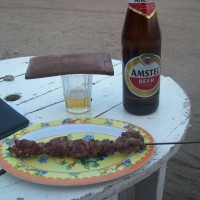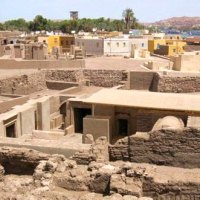
- Processing Cassava into flour
For several hundreds of years cassava has been a key, basic food throughout most of tropical Africa. However, it suffers from several major drawbacks:
(1) There are two varieties, but one is quite poisonous without proper processing;
(2) The non-poisonous, or ‘sweet’ manioc, while easier to process, is also less prolific in the field;
(3) Over the last couple of decades cassava across Africa has been striken by several viral diseases that are decimating the crops.
(4) Cassava is nutritionally terrible – a practically empty carbohydrate.
As Sir Burton quipped while travelling in the lower Congo in 1863:
At the last moment the men [his carriers] found that they had no ‘chop’, a franc produced two bundles of sweet manioc, good travelling food, as it can be eaten raw, but about as nutritious as Nowegian bark…
Source: Richard Burton – Two Trips to Gorilla Land and the Cataracts of the Congo. Vol.2 1876 [Trip = 1863]
However, cassava has a number of highly positive attributes:
(1) Can be grown in extremely bad soils and it will thrive
(2) Can be left in the ground for long periods of time (months) prior to harvesting
(3) Is multipurpose – the leaves, which are quite nutritious, are used to make a delicious relish, called sombé here, that is eaten with stiff porridge made of manioc flour
(4) Can be dried and made into flour (and then into stiff porridge)
(5) Requires very little care in the field
I will turn back to these positive and negative attributes in a future blog, but in this and an upcoming blog want to provide a bit of historical context on the importance of cassava and on it extensive cultivation, as recorded by colonial explorers.
Area of the Shire River in southern Africa:
Livingstone and his party had been extremely ill, from mysterious causes. He speculates:
…Our illness may partly have arisen from another cause. One kind of cassava (_Jatropha maligna_) is known to be, in its raw state, poisonous, but by boiling it carefully in two waters, which must be thrown off, the poison is extracted and the cassava rendered fit for food. The poisonous sort is easily known by raising a bit of the bark of the root, and putting the tongue to it. A bitter taste shows poison, but it is probable that even the sweet kind contains an injurious principle…
…Our cook, however, boiled the cassava root as he was in the habit of cooking meat, namely, by filling the pot with it, and then pouring in water, which he allowed to stand on the fire until it had become absorbed and boiled away. This method did not expel the poisonous properties of the root, or render it wholesome; for, notwithstanding our systematic caution in purchasing only the harmless sort, we suffered daily from its effects, and it was only just before the end of our trip that this pernicious mode of boiling it was discovered by us…
The country around is elevated, undulating, and very extensively planted with cassava. The hoe in use has a handle of four feet in length, and the iron part is exactly of the same form as that in the country of the Bechuanas. The baskets here, which are so closely woven together as to hold beer, are the same with those employed to hold milk in Kaffirland–a thousand miles distant…
From: A Popular Account of Dr. Livingstone’s Expedition to the Zambesi and Its Tributaries and of the Discovery of the Lakes Shirwa and Nyassa (1858-1864)
S.W. of Lake Tanganyika:
Cassava is very extensively cultivated, indeed, so generally is this plant grown, that it is impossible to know which is town and which is country: every hut has a plantation around it, in which is grown cassava, Holcus sorghum, maize, beans, nuts…
They [his carriers] stole cassava as we went along, but this could scarcely be prevented. They laid hold of a plant an inch-and-a-half thick, and tore it out of the soft soil with its five or six roots as large as our largest carrots, stowed the roots away in their loads, and went on eating them; but the stalk thrown among those still growing shows the theft. The raw roots are agreeable and nutritious. No great harm is done by this, for the gardens are so large, but it inspires distrust in the inhabitants…
On the way to this village from the south we observed an extensive breadth of land, under ground-nuts which are made into oil: a large jar of this is sold for a hoe. The ground-nuts were now in flower, and green maize ready to be eaten. People all busy planting, transplanting, or weeding; they plant cassava on mounds prepared for it, on which they have sown beans, sorghum, maize, pumpkins: these ripen, and leave the cassava a free soil. The sorghum or dura is sown thickly, and when about a foot high–if the owner has been able to prepare the soil elsewhere–it is transplanted, a portion of the leaves being cut off to prevent too great evaporation and the death of the plant…
The Wanyamwesi here support themselves by shooting buffaloes [Cape Buffalo], at a place two days distant, and selling the meat for grain and cassava: no sooner is it known that an animal is killed, than the village women crowd in here, carrying their produce to exchange it for meat, which they prefer to beads or anything else. Their farinaceous food creates a great craving for flesh: were my shoes not done I would go in for buffaloes too [Livingstone’s shoes were quite worn out, so that he wasn’t able to join in the buffalo hunting]…
_2nd June, 1868._–In passing a field of cassava I picked the pods of a plant called Malumbi*, which climbs up the cassava bushes; at the root it has a number of tubers with eyes, exactly like the potato. One plant had sixteen of these tubers, each about 2 inches long and 1-1/2 inch in diameter: another tuber was 5 inches long and 2 in diameter, it would be difficult for anyone to distinguish them from English potatoes. When boiled they are a little waxy, and, compared with our potato, hard. There are colours inside, the outer part reddish, the inner whiter. At first none of the party knew them, but afterwards they were recognised as cultivated at Zanzibar by the name “Men,” and very good when mashed with fish: if in Zanzibar, they are probably known in other tropical islands,..
* This is the Livingstone, or Native potato – an important ‘Lost Crop’ of Africa. See this Blog: INUMPU – Burundi’s Indigenous Potatoes & A Recipe
Vol. 2:
In the region of the Lualaba Riven, in current E. Congo:
_7th September, 1869._–W. and N.W., through forest and immense fields of cassava, some three years old, with roots as thick as a stout man’s leg…
_8th September, 1869._–Across five rivers and through many villages. The country is covered with ferns and gingers, and miles and miles of cassava…
The women are very naked. They bring loads of provisions to sell, through the rain, and are eager traders for beads. Plantains, cassava, and maize, are the chief food. The first rains had now begun, and the white ants took the hint to swarm and colonize…
White ants, fried in oil, are a great treat throughout much of Africa at the beginning of the rainy season. It is a tasty snack and also source of protein for many See this blog: Ant Culture and Cuisine in Africa, 19th Century and Now
The Manyuema hoeing is little better than scraping the soil, and cutting through the roots of grass and weeds, by a horizontal motion of the hoe or knife; they leave the roots of maize, ground-nuts, sweet potatoes, and dura, to find their way into the rich soft soil, and well they succeed, so there is no need for deep ploughing: the ground-nuts and cassava hold their own against grass for years…
2nd April, 1871._–To-day the market contained over a thousand people, carrying earthen pots and cassava, grass cloth, fishes, and fowls; they were alarmed at my coming among them and were ready to flee, many stood afar off in suspicion; some came from the other side of the river with their goods. To-morrow market is held up river…
_24th May, 1871._–The market is a busy scene–everyone is in dead earnest–little time is lost in friendly greetings; vendors of fish run about with potsherds full of snails or small fishes or young _Clarias capensis_ smoke-dried and spitted on twigs, or other relishes to exchange for cassava roots dried after being steeped about three days in water–potatoes [probably sweet potatoes], vegetables, or grain, bananas, flour, palm-oil, fowls, salt, pepper; each is intensely eager to barter food for relishes, and makes strong assertions as to the goodness or badness of everything: the sweat stands in beads on their faces–cocks crow briskly, even when slung over the shoulder with their heads hanging down, and pigs squeal…
From: The Last Journals of David Livingstone, in Central Africa, from 1865 to His Death, Volume I (of 2), 1866-1868

Cassava harvesting in Uganda. Source: USAID - Uganda
More blogs coming on cassava…
Related articles
- Liloan Liempo and Cassava Creme (derdo.wordpress.com)
- Global Update: Food: Deal Will Help Build a Better Cassava (nytimes.com)
- The Gates Foundation and GMO Food (bigthink.com)
- Some Fruit Seeds Contain Cyanide (brokensecrets.com)


























Pingback: Gorilla Trekking
Pingback: Multipurpose Crops in Africa & Dates in the Sahara, 1859 « Dianabuja's Blog
I ate cassava leaf sauce over rice while in West Africa years ago, but the root always looked pretty unappetizing. The sauce was great! I suspect the leaf has way more nutrients anyway.
LikeLike
Yes, the leaves are high in protein and a relish made of them, with palm oil and tomatoes, greatly offsets the bland nutrients of the root.
LikeLike
Pingback: Cassava: a historical perspective
Pingback: Cassava in Context, Views from the 19th Century, II of II « Dianabuja's Blog